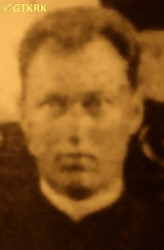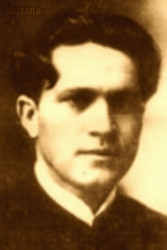Roman Catholic
St Sigismund parish
05-507 Słomczyn
85 Wiślana Str.
Konstancin deanery
Warsaw archdiocese, Poland
full list:
displayClick to display full list

searchClick to search full list by categories
wyświetlKliknij by wyświetlić pełną listę po polsku

szukajKliknij by przeszukać listę wg kategorii po polsku

Martyrology of the clergy — Poland
XX century (1914 – 1989)
personal data
surname
JURKIEWICZ
forename(s)
George (pl. Jerzy)

function
diocesan priest
creed
Latin (Roman Catholic) Church RCmore on
en.wikipedia.org
[access: 2014.09.21]
diocese / province
Mogilev archdiocesemore on
en.wikipedia.org
[access: 2013.06.23]
date and place
of death
04.06.1942

ITL SibLagGuLAG slave labour camp network
today: Novoivanovka, Kemerovo oblast, Russia
more on
ru.wikipedia.org
[access: 2024.01.29]
alt. dates and places
of death
1937, 04.12.1941
details of death
In 1926‐1928 evicted from his rectory, as all other parish property confiscated and robbed by the Russians.
Moved to a small room at one his parishioners flats.
Next moved to small house 15 km from Vladivostok.
Arrested by the Russians on 02.12.1931.
For c. 2 months held in solitary cell in Vladivostok prison.
Accused of espionage for Poland and Japan, anti–Russian activities and illegal speculation in foreign currencies and gold.
On 06.02.1932 sentenced to 10 years of slave labour in Russian concentration camps.
Prob. initially held in ITL SibLag concentration camp.
In 1932 prob. transferred to Solovetsky Islands ITL SLON concentration camp.
In 1937 transported back to ITL SibLag, to Yaya Station camp in Kemerovo Oblast.
There are reports that he still lived in 1941, terribly tortured, with one eye gauged out.
On 01.12.1941 should have been released.
Prob. perished in a concentration camp n. Novoivanovka village in Kemerovo Oblast, part of ITL SibLag concentration camp, in unknown circumstances.
One of ITL SibLag prisoners' cemeteries was situated nearby.
cause of death
extermination
perpetrators
Russians
sites and events
ITL SibLagClick to display the description, Great Purge 1937Click to display the description, ITL SLONClick to display the description, GulagClick to display the description
date and place
of birth
05.04.1884

Timkovichitoday: Timkovichi ssov., Kapyl dist., Minsk reg., Belarus
more on
be.wikipedia.org
[access: 2022.07.20]
alt. dates and places
of birth
25.04.1887
presbyter (holy orders)
ordination
1910

positions held
1923 – 1931
parish priest — Vladivostoktoday: Primorsky Krai, Russia
more on
en.wikipedia.org
[access: 2022.02.04] ⋄ Nativity of the Blessed Virgin Mary RC parish
from 1912
priest — Khabarovsktoday: Khabarovsk Krai, Russia
more on
en.wikipedia.org
[access: 2022.06.29] ⋄ Immaculate Conception of the Blessed Virgin Mary RC church (fillial) ⋄ Vladivostoktoday: Primorsky Krai, Russia
more on
en.wikipedia.org
[access: 2022.02.04], Nativity of the Blessed Virgin Mary RC parish — chaplain of the local Military Academy and catechist of the girls' high school
from 1912
priest — Nikolayevsk‐on‐Amurtoday: Nikolayevsk‐on‐Amur reg., Khabarovsk Krai, Russia
more on
en.wikipedia.org
[access: 2021.12.18] ⋄ RC chapel ⋄ Vladivostoktoday: Primorsky Krai, Russia
more on
en.wikipedia.org
[access: 2022.02.04], Nativity of the Blessed Virgin Mary RC parish
till 1912
vicar — Krasnoyarsktoday: Krasnoyarsk city reg., Krasnoyarsk Krai, Russia
more on
en.wikipedia.org
[access: 2022.08.05] ⋄ Transfiguration of the Lord RC parish ⋄ Irkutsktoday: Irkutsk oblast, Russia
more on
en.wikipedia.org
[access: 2022.04.17] RC deanery
till 1910
student — Sankt Petersburgtoday: Saint Petersburg city, Russia
more on
en.wikipedia.org
[access: 2020.07.31] ⋄ philosophy and theology, Metropolitan Theological Seminary
sites and events
descriptions
ITL SibLag: Russian Rus. Исправи́тельно‐Трудово́й Ла́герь (Eng. Corrective Labor Camp) ITL Rus. Сибирский (Eng. Siberian) — concentration and slave forced labor camp (within the Gulag complex) — headquartered in Mariinsk in Kemerovo Oblast, where a central camp for invalids was also operational (moved twice to Novosibirsk, c. 350 km away). Founded in 1929. One of the largest — initially spread over large area from Omsk to Krasnoiarsk, as a matter of fact whole Western Siberian Plain, next subdivided and limited to Novosibirsk, Tomsk and Kemerovo oblasts. Up to 80,000 inmates were held in SibLag: e.g. 78,838 (01.01.1938); 77,919 (01.01.1942); 70,370 (01.04.1942). Prisoners slaved at railroad construction, forestry, carpentry and in coal mines, and other industrial branches (brick, clothing, leather and fur factories and plants). Closed down in c. 1960. (more on: tspace.library.utoronto.caClick to attempt to display webpage
[access: 2018.09.02], www.gulagmuseum.orgClick to attempt to display webpage
[access: 2014.05.09])
Great Purge 1937: „Great Terror” (also «Great Purge», also called „Yezhovshchyna” after the name of the then head of the NKVD) — a Russian state action of political terror, planned and directed against millions of innocent victims — national minorities, wealthier peasants (kulaks), people considered opponents political, army officers, the greatest intensity of which took place from 09.1936 to 08.1938. It reached its peak starting in the summer of 1937, when Art. 58‐14 of the Penal Code about „counter‐revolutionary sabotage” was passed , which became the basis for the „legalization” of murders, and on 02.07.1937 when the highest authorities of Russia, under the leadership of Joseph Stalin, issued a decree on the initiation of action against the kulaks. Next a number of executive orders of the NKVD followed, including No. 00439 of 25.07.1937, starting the liquidation of 25,000‐42,000 Germans living in Russia (mainly the so‐called Volga Germans); No. 00447 of 30.07.1937, beginning the liquidation of „anti‐Russian elements”, and No. 00485[2] of 11.08.1937, ordering the murder of 139,835 people of Polish nationality (the latter was the largest operation of this type — encompassed 12.5% of all those murdered during the «Great Purge», while Poles constituted 0.4% of the population). In the summer of 1937 Polish Catholic priests held in Solovetsky Islands, Anzer Island and ITL BelbaltLag were locked in prison cells (some in Sankt Petersburg). Next in a few kangaroo, murderous Russian trials (on 09.10.1937, 25.11.1937, among others) run by so‐called «NKVD Troika» all were sentenced to death. They were subsequently executed by a single shot to the back of the head. The murders took place either in Sankt Petersburg prison or directly in places of mass murder, e.g. Sandarmokh or Levashov Wilderness, where their bodies were dumped into the ditches. Other priests were arrested in the places they still ministered in and next murdered in local NKVD headquarters (e.g. in Minsk in Belarus), after equally genocidal trials run by aforementioned «NKVD Troika» kangaroo courts.
ITL SLON: Russian Rus. Исправи́тельно‐Трудово́й Ла́герь (Eng. Corrective Labor Camp) ITL Rus. Солове́цкий ла́герь осо́бого назначе́ния Ла́герь (Eng. Solovetsky Special Purpose Camp) SLON — concentration and slave forced labor camp (within what was to become Gulag complex) — headquartered in Solovetsky Islands in Arkhangelsk Oblast. Founded on 13.10.1923 in a famous Orthodox monastery. In the 1920s, one of the first and largest concentration camps in Russia. The place of slave labor of prisoners — at forest felling, sawmills, peat extraction, fishing, loading work on the Murmansk Railway Main Line, in road construction, production of food and consumer goods, at the beginning of the construction of the White Sea ‐ Baltic canal, etc. The concept of the later system of Russian Gulag concentration camps prob. had its origins in the Solovetsky Islands camp — from there the idea spread to the camps in the area covered by the construction of the White Sea ‐ Baltic canal, i.e. ITL BelBaltLag, and from there further, to the entire territory of the Russian state. From the network of camps on the Solovetsky Islands — also called the Solovetsky Islands archipelago — prob. also comes the concept of the „Gulag Archipelago” created by Alexander Solzhenitsyn. It is estimated that tens to hundreds of thousands of prisoners passed through the Solovetsky Islands concentration camps. At its peak, c. 72,000 prisoners were held there: e.g. 14,810 (12.1927); 12,909 (03.1928); 65,000 (1929); 53,123 (01.01.1930); 63,000 (01.06.1930); 71,800 (01.01.1931); 15,130 (1932); 19,287 (1933) — c. 43,000 of whom were murdered, including the years 1937‐1938 when c. 9,500 prisoners were transported from the camp and murdered in several places of mass executions, including Sandarmokh, Krasny Bor and Lodeynoye Polye. Among them were many Catholic and Orthodox priests. After the National Socialist Party came to power in Germany in 1933, a German delegation visited the ITL SLON camp, to „inspect” Russian solutions and adopt them later in German concentration camps. It operated until 04.12.1933, with a break from 16.11.1931 to 01.01.1932, when it was part of and later became a subcamp of the ITL BelBaltLag camp. It operated as such until 1939 (from 1936 as a prison). (more on: old.memo.ruClick to attempt to display webpage
[access: 2024.04.08])
Gulag: The acronym Gulag comes from the Rus. Главное управление исправительно‐трудовых лагерей и колоний (Eng. Main Board of Correctional Labor Camps). The network of Russian concentration camps for slave labor was formally established by the decision of the highest Russian authorities on 27.06.1929. Control was taken over by the OGPU, the predecessor of the genocidal NKVD (from 1934) and the MGB (from 1946). Individual gulags (camps) were often established in remote, sparsely populated areas, where industrial or transport facilities important for the Russian state were built. They were modeled on the first „great construction of communism”, the White Sea‐Baltic Canal (1931‐1932), and Naftali Frenkel, of Jewish origin, is considered the creator of the system of using forced slave labor within the Gulag. He went down in history as the author of the principle „We have to squeeze everything out of the prisoner in the first three months — then nothing is there for us”. He was to be the creator, according to Alexander Solzhenitsyn, of the so‐called „Boiler system”, i.e. the dependence of food rations on working out a certain percentage of the norm. The term ZEK — prisoner — i.e. Rus. заключенный‐каналоармец (Eng. canal soldier) — was coined in the ITL BelBaltLag managed by him, and was adopted to mean a prisoner in Russian slave labor camps. Up to 12 mln prisoners were held in Gulag camps at one time, i.e. c. 5% of Russia's population. In his book „The Gulag Archipelago”, Solzhenitsyn estimated that c. 60 mln people were killed in the Gulag until 1956. Formally dissolved on 20.01.1960. (more on: en.wikipedia.orgClick to attempt to display webpage
[access: 2024.04.08])
sources
personal:
biographies.library.nd.eduClick to attempt to display webpage
[access: 2014.12.20], vladmission.orgClick to attempt to display webpage
[access: 2019.02.02], zeslaniec.plClick to attempt to display webpage
[access: 2019.02.02]
bibliographical:
„Fate of the Catholic clergy in USSR 1917‐1939. Martyrology”, Roman Dzwonkowski, SAC, ed. Science Society KUL, 2003, Lublin
original images:
vladmission.orgClick to attempt to display webpage
[access: 2019.02.02]
LETTER to CUSTODIAN/ADMINISTRATOR
If you have an Email client on your communicator/computer — such as Mozilla Thunderbird, Windows Mail or Microsoft Outlook, described at WikipediaPatrz:
en.wikipedia.org, among others — try the link below, please:
LETTER to CUSTODIAN/ADMINISTRATORClick and try to call your own Email client
If however you do not run such a client or the above link is not active please send an email to the Custodian/Administrator using your account — in your customary email/correspondence engine — at the following address:

giving the following as the subject:
MARTYROLOGY: JURKIEWICZ George
To return to the biography press below:
 Click to return to biography
Click to return to biography









